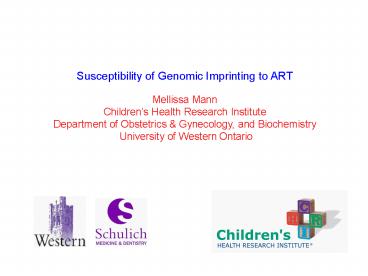Susceptibility of Genomic Imprinting to ART - PowerPoint PPT Presentation
1 / 32
Title:
Susceptibility of Genomic Imprinting to ART
Description:
Susceptibility of Genomic Imprinting to ART Mellissa Mann Children s Health Research Institute Department of Obstetrics & Gynecology, and Biochemistry – PowerPoint PPT presentation
Number of Views:143
Avg rating:3.0/5.0
Title: Susceptibility of Genomic Imprinting to ART
1
Susceptibility of Genomic Imprinting to
ART Mellissa Mann Childrens Health Research
Institute Department of Obstetrics Gynecology,
and Biochemistry University of Western Ontario
2
Infertility and Assisted Reproductive Technologies
35-70 million couples involuntarily infertile
1 in 6 people of reproductive age
?
ART
3
Children conceived via ARTs are at increased risk
- Intrauterine growth retardation
- Premature birth
- Low birth weight
- Possibly genetic disorders
4
ART-induced perturbations in the mouse
- Reduced viability
- Intrauterine growth retardation
- Developmental abnormalities
- Deviation in behaviour
5
Developmental abnormalities in in vitro produced
livestock
6
Epigenetics Heritable alterations in gene
activity without a change in DNA sequence
Skinny and Brown
Obese and Yellow
7
Epigenetics Mediator of Environment,
Development, and Disease
Epigenetics
8
Genomic Imprinting The unequal expression of the
maternal and paternal alleles of a gene
Paternal allele
Maternal allele
Maternal allele Paternal allele
Imprinted or marked with their gametic-origin
9
Mouse/Human Imprinted Domains
Kcnq1
Cd81
Slc22a1l
Mouse Distal 7/ Human 11p15.5
Ascl2
Th
Ins2
Igf2
Nap1l4
Tssc3
Cdkn1c
Kcnq1ot1
H19
Snurf
Snrpn
Magel2
Ndn
Ipw
Ube3A
Atp10c
snoRNA Genes
Mouse Central 7/ Human 15q11-13
IC
Frat3
Mkrn3
IC Antisense
10
Methylation changes during mouse preimplantation
development
Paternal Genome
Maternal Genome
11
Are genomic imprints maintained in
preimplantation embryos after in vitro culture?
12
B6(CAST7) mice for use in allelic analyses
B6(CAST7)
CAST
Chromosome 7
F1
X
CAST
B6
B6
B6
13
In vitro preimplantation culture regimes
Trophectoderm
ICM
Whittens
KSOMaa
2-cell
Blastocyst
14
Loss of H19 imprinted expression occurs in a
subset of individual blastocysts after culture in
Whittens medium
100 80 60 40 20 0
100 80 60 40 20 0
Vivo
1 2 3 4 5 6 7 8 9 10 11 12 13 14
15 16 17
100 80 60 40 20 0
100 80 60 40 20 0
KSOMaa
1 2 3 4 5 6 7 8 9 10 11 12 13
14 15 16 17 18 19 20 21
100 80 60 40 20 0
Whittens
1 2 3 4 5 6 7 8 9 10 11 12 13
14 15 16 17 18 19 20 21 22 23 24 25 26 27 28 29
30 31 32 33 34 35 36 37 38
Blastocyst
Paternal
Maternal
15
Loss of imprinting occurred during
preimplantation development in culture,
indicating that mechanisms that operate to
maintain imprinting were disrupted.
16
What are the long-term effects of preimplantation
development in culture?
Cultured Blastocysts
Recipient Mothers
17
Postimplantation embryos recovered at 9.5 days of
pregnancy after preimplantation culture in
Whittens medium.
18
Loss of imprinted expression occurs primarily in
day 9.5 placentas after preimplantation culture
100 80 60 40 20 0
H19
100 80 60 40 20 0
Paternal
Ascl2
100 80 60 40 20 0
Maternal
Snrpn
100 80 60 40 20 0
Peg3
Whittens
KSOMaa
Whittens
KSOMaa
Vivo
Vivo
Embryo
Placenta
19
Loss of imprinted expression occurs primarily in
day 9.5 placentas after preimplantation culture
H19
Ascl2
Snrpn
Peg3
W
K
W
K
V
V
Embryo
Placenta
20
Perturbations in imprinting persist long after
embryos have been removed from culture.
21
Loss of imprinting occurs more frequently in
extraembryonic than embryonic lineages
Proximity to culture? ICM vs TE? Less redundancy?
22
ART children diagnosed with imprinting disorders
Beckwith-Wiedemann Syndrome
Biparental origin
Normal
Biparental origin
Sporadic imprinting defects may arise during ART
procedures
23
Assisted Reproductive Technologies
PGC
Oocyte maturation
Humans
Superovulation /- GnRH treatment
Oocyte retrieval
IVF/ICSI
In vitro culture
Mice
Superovulation
In vitro culture
24
Future Studies Assisted Reproductive Technologies
PGC
Oocyte maturation
Mice
Superovulation
In vitro culture
25
1. Determine whether superovulation contributes
to loss of imprinting
Spontaneous vs Induced Ovulation
26
2. Determine when imprint maintenance is lost
during preimplantation development in culture.
In vitro culture
Examine imprinting of H19, Snrpn, Kcnq1ot1, Peg3
27
3. Does loss of imprinting occur in mouse embryos
cultured in media used in human assisted
reproduction?
Trophectoderm
H19 Snrpn Peg3 Kncq1ot1
Global
One Step
HTF
Two Step
2-cell
G1.2/G2.2
H19 Snrpn Peg3 Kncq1ot1
P-1/Bl SSS
Blastocyst
28
4. Determine how disruptions lead to the
selective loss of imprinting in the placenta
Left horn
Right horn
In Vivo derived
Whittens
Right horn
Day 5.5
Day 6.5
Day 7.5
Day 8.5
Examine imprinting of H19, Snrpn, Kcnq1ot1, Peg3
29
5. Determine the long-term affects of
preimplantation culture on genomic imprinting and
development
Left horn
Right horn
In Vivo derived
Whittens
Ultrasound biomicroscopy
Day 9.5, Day 13.5, Day 17.5
30
Ultrasound biomicroscopy at Day 9.5-10.5 of
gestation Growth and Viability
Crown-rump length
Resorption
Variable embryonic growth
Calcium hydroxyapatite deposits
31
Ultrasound biomicroscopy at Day 13.5 of gestation
Beckwith-Wiedemann Syndrome
Macrosomia
Visceromegaly (liver, heart)
Macroglossia ( tongue)
Abdominal wall defects
Polydactyly (limb)
Cardiac defects (heart)
Adrenal defects
Lens defects (eye)
Vertebral defects
Hemihypertrophy
Polyhydramnios
Placentomegaly/Placental hydrops
32
Acknowledgements
University of Pennsylvania
Michael Golding Anne Pin Liyue Zhang Sarah
Lalone Julia Foster Brenna Market Lauren
Magri Michelle Gabriel Morgan McWilliam
Marisa Bartolomei Richard Schultz































